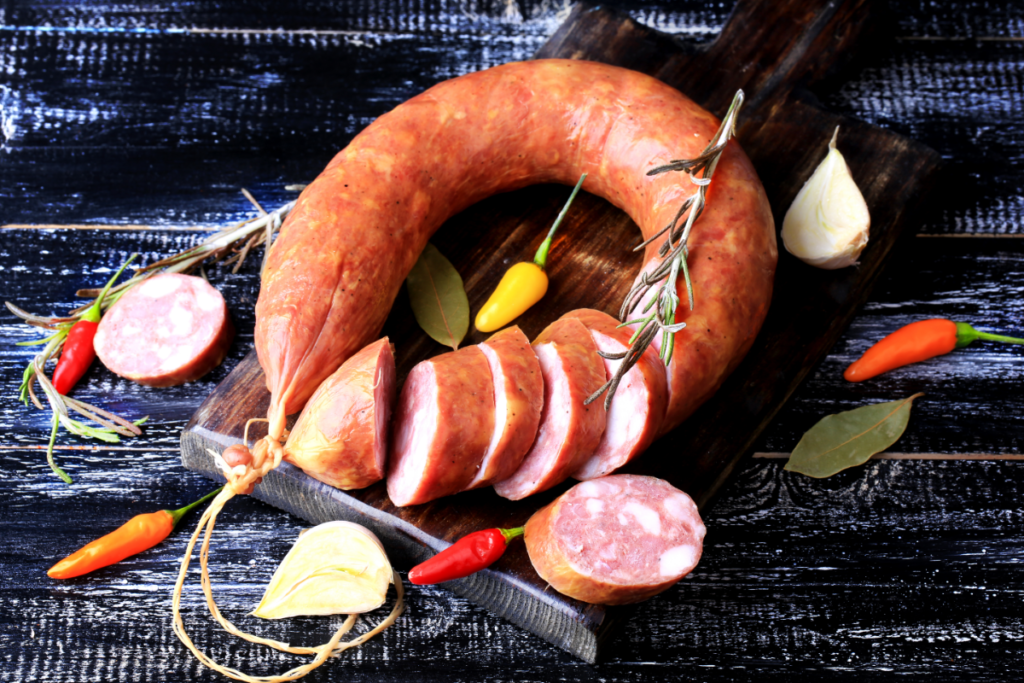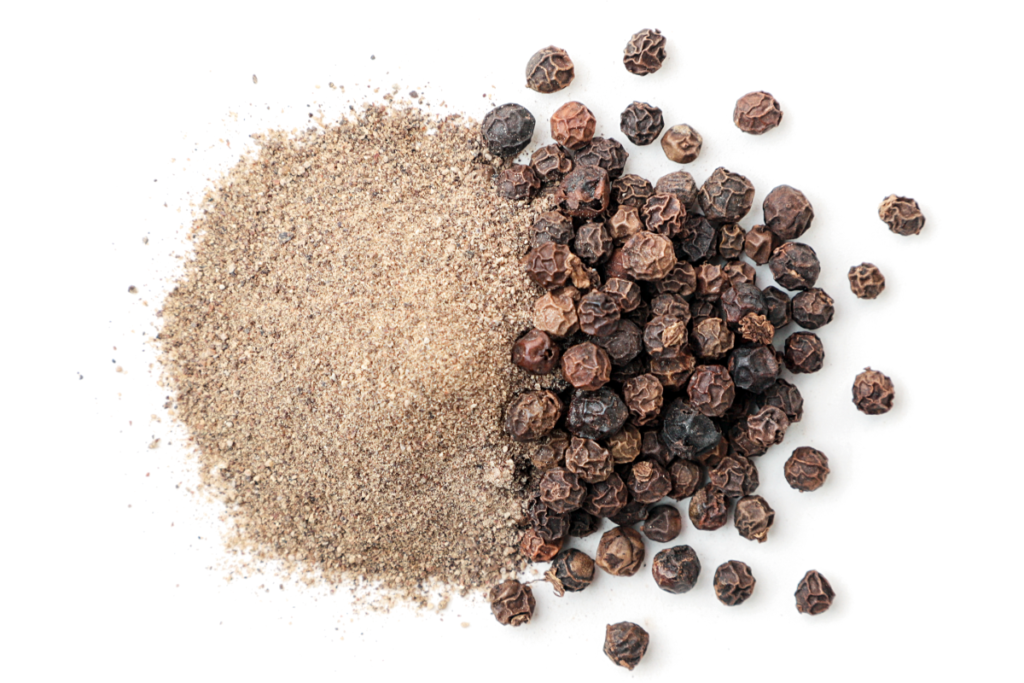Spices are the key to tasty homemade foods. Explore the world of sausage seasoning and spices to elevate your cookery. This thorough book includes professional guidance, tasty recipes, and sausage spice mix customization recommendations.
Learning sausage seasoning will improve your cooking abilities, regardless of your experience. You’ll learn how to make delicious breakfast sausages and innovative flavor combinations to wow your family and friends.
With the correct sausage flavor and spices, you may be creative with homemade dinners. So prepare for a savory voyage and improve your cooking with professional instruction and great recipes. Master sausage seasoning and spices to make every dish unforgettable!
The Basics of Sausage Seasoning

When it comes to creating delicious sausages, mastering the art of sausage seasoning is essential. Understanding the basics of sausage seasoning will help you achieve mouthwatering results every time. It all starts with selecting the right combination of spices and herbs to bring out the desired flavors in your sausages.
Spices and herbs are the building blocks of flavorful sausages. From classic spices like black pepper and paprika to aromatic herbs like thyme and rosemary, each ingredient adds depth and complexity to your sausages. By experimenting with different spices and herbs, you can create unique flavor profiles that suit your taste preferences.
The Best Sausage Seasoning and Spices

The right seasoning and spices are crucial in creating the perfect flavor. Below are some of the best sausage seasoning and spices that can elevate your sausage-making game. From classic breakfast sausages to spicy chorizo and more, we’ll help you understand which flavors work best for different types of sausages.
🌭Classic Breakfast Sausage Seasoning:
For a traditional breakfast sausage, start with a blend of ground sage, black pepper, and a hint of brown sugar. Sage gives it that distinct, earthy flavor, while black pepper adds a little kick. The touch of brown sugar brings a subtle sweetness that balances the spices.
🌭Italian Sausage Seasoning:
Italian sausages are known for their robust and aromatic flavors. To achieve this, you’ll need fennel seeds, paprika, crushed red pepper flakes, and garlic powder. Fennel seeds impart a slightly licorice-like taste, while paprika and red pepper flakes provide a gentle heat. Garlic powder contributes depth and richness to the mix.
🌭Chorizo Sausage Seasoning:
Chorizo sausages are famous for their bold and spicy taste. To create this seasoning, combine smoked paprika, ground cumin, cayenne pepper, and a touch of garlic powder. The smokiness from paprika and the heat from cayenne and cumin give chorizo its fiery character.
🌭Bratwurst Sausage Seasoning:
Bratwurst sausages are milder in flavor but still pack a punch. To achieve the traditional taste, use ground white pepper, nutmeg, and a bit of coriander. White pepper offers a gentle heat, nutmeg contributes a warm, nutty undertone, and coriander adds a hint of citrusy brightness.
🌭Cajun-Style Sausage Seasoning:
Cajun sausages are known for their zesty and vibrant flavors. Create a Cajun-style blend with paprika, cayenne pepper, thyme, oregano, and garlic powder. The combination of paprika and cayenne brings the heat, while thyme and oregano provide earthy and herbal notes.
These spice blends are just a starting point, and you can always experiment to find the flavors that suit your taste preferences. Remember, making sausages is not just about following a recipe; it’s about adding your unique twist to create something truly special.
Customizing Your Sausage Seasoning Blend
One of the joys of sausage making is the ability to customize your seasoning blend to create unique flavors that cater to your taste preferences. With some experimentation, you can take your homemade sausages to the next level and impress your family and friends.
To start customizing your sausage seasoning blend, begin by selecting a base of herbs and spices that you enjoy. Common choices include thyme, rosemary, garlic powder, paprika, and chili flakes. These ingredients provide a solid foundation for flavor, and from here, you can build upon and personalize your blend.
Don’t be afraid to get creative and try new combinations of spices and herbs. Whether you prefer a spicy kick, a smoky aroma, or a delicate balance of flavors, the possibilities are endless. Remember to start with small amounts and taste as you go, adjusting the seasoning until you achieve the desired flavor.
━Experiment to Unlock Unique Flavors━
Customizing your sausage seasoning blend is all about experimentation. Add a pinch of cinnamon for warmth, or experiment with exotic spices like cumin, coriander, or turmeric to create unexpected flavor profiles. You never know what unique combination will turn your sausages into culinary masterpieces!
Additionally, consider incorporating ingredients like dried fruits, nuts, or cheese into your blend for added texture and complexity. The key is to have fun and let your taste buds guide you on this flavorful journey.
By customizing your sausage seasoning blend, you can create sausages that are truly your own. Whether you’re whipping up a savory breakfast sausage or a spicy Italian variety, don’t be afraid to unleash your creativity in the kitchen and explore the endless possibilities of flavors that await!
Marinating Sausage Meat

Marinating sausage meat is a fantastic technique to infuse it with additional flavors and enhance its tenderness. By creating a marinade using a combination of herbs, spices, oils, and acids, you can take your sausages to a new level of deliciousness. Marinating allows the flavors to penetrate the meat, resulting in a flavor infusion that will delight your taste buds.
📌Flavor Infusion
When marinating sausage meat, the goal is to achieve a harmonious blend of flavors. The marinade acts as a medium to carry the flavors deep into the meat, transforming it from ordinary to extraordinary. By combining ingredients such as garlic, onion, thyme, rosemary, soy sauce, or citrus juices, you can create a flavor profile that complements the natural taste of the sausage. Allow the meat to marinate for a few hours or overnight to allow the flavors to fully develop.
📌Tenderization Techniques
In addition to infusing flavor, marinating also helps to tenderize the sausage meat. The acids present in the marinade, such as vinegar or citrus juices, work to break down the proteins in the meat, resulting in a more tender texture. For even more tenderization, consider using a meat tenderizer tool or piercing the sausages with a fork before marinating. This will allow the marinade to penetrate deeper into the meat, enhancing flavor and tenderness.
📌Recipes and Techniques
Ready to try your hand at marinating sausage meat? Here are a few recipes and techniques to get you started:
- Mediterranean Marinade: Combine olive oil, lemon juice, garlic, oregano, and black pepper for a bright and tangy flavor.
- Asian-inspired Marinade: Mix soy sauce, ginger, garlic, honey, and sesame oil for a savory and slightly sweet profile.
- Beer Marinade: Create a marinade using your favorite beer, Worcestershire sauce, brown sugar, and mustard for a rich and robust taste.
Remember to adjust the quantities of the ingredients to suit your personal preference and the amount of sausage meat you are marinating.
Storage and Long-Term Preservation
Proper storage and long-term preservation are essential for maintaining the freshness and quality of your sausage seasoning and spices. By following the right storage methods, you can ensure that your spices remain flavorful and potent for an extended period, allowing you to continue creating delicious sausages with confidence.
When storing sausage seasoning and spices, it’s important to keep them in a cool, dry, and dark place. Exposing these ingredients to heat, moisture, and sunlight can cause them to lose their flavor and potency. To maximize their shelf life, consider using airtight containers or glass jars with tight-fitting lids to protect them from air and humidity.
For long-term preservation of your sausage seasoning blends, you may also consider freezing them. Freezing can help retain their freshness and flavor for a more extended period. Divide your spices into small portions and store them in airtight freezer bags or containers. Label them with the date of freezing to keep track of their freshness.
Remember to check the quality of your stored spices periodically. Over time, spices may lose their potency and aroma. If you notice any signs of deterioration, such as a weak fragrance or dull color, it may be time to replace them. Freshness is key to achieving the best flavors in your sausages, so ensure you have high-quality spices on hand for optimal seasoning results.
Ground Spices vs. Whole Spices

When it comes to sausage seasoning, the choice between ground spices and whole spices can have a significant impact on the flavor intensity and convenience of your creations. Ground spices, such as ground black pepper or ground paprika, are easily accessible and instantly release their flavors into the sausage mixture. They are perfect for those seeking a quick and convenient way to add spice to their sausages. Plus, with ground spices, you won’t have to worry about grinding them yourself.
On the other hand, whole spices, like whole coriander seeds or whole mustard seeds, provide a more potent and distinct flavor profile. Using whole spices, you can infuse your sausages with the essence of the spice while preserving its natural oils and aromas. However, remember that whole spices require grinding before use, which adds an extra step to the preparation process.
━Enhancing Flavor and Convenience━
Both ground spices and whole spices have their advantages and disadvantages, so it’s essential to consider your desired flavor intensity and convenience level. If you’re looking for a more robust and pronounced spice flavor, whole spices are the way to go. Grinding them right before adding them to your sausage mixture will result in a burst of aroma and flavor. However, if you prefer a more mellow and evenly distributed spice blend, ground spices offer convenience and ease of use.
Ultimately, the choice between ground spices and whole spices depends on your personal preference and the specific flavor profile you want to achieve. Feel free to experiment with both options to find the perfect balance of flavor intensity and convenience that suits your taste buds. Whichever type of spice you choose, the key is to use high-quality and freshly ground spices for the best results.
Fresh Herbs vs. Dried Herbs
When it comes to sausage seasoning, the choice between fresh herbs and dried herbs is a matter of personal preference and availability. Both options have unique qualities and can contribute to the flavor profile of your sausages.
Fresh herbs are known for their vibrant colors, delicate flavors, and aromatic qualities. They can bring a fresh and lively element to your sausages, elevating them to a whole new level. However, they can be more challenging to source depending on the season and may have a shorter shelf life. Using fresh herbs requires careful handling and precise measurements, as their potency can vary.
Dried herbs, on the other hand, offer convenience and versatility. They are readily available year-round and have a longer shelf life, making them a staple in many kitchens. Dried herbs have a more concentrated flavor, which adds depth and complexity to your sausages. They are also more forgiving regarding measurements, as their flavors are often consistent. However, it’s important to note that some delicate herbs may lose their potency when dried, so be mindful of the specific herbs you choose.
━Choosing the Right Option for Your Sausages━
Both fresh herbs and dried herbs have their place in sausage making. Consider the flavor profile you want to achieve and the availability of herbs in your area. If you can access fresh herbs, use their vibrant flavors and experiment with combinations to create unique blends. On the other hand, if fresh herbs are not easily accessible, dried herbs can be a reliable alternative that still delivers excellent results.
Ultimately, choosing between fresh and dried herbs depends on personal preference and the specific flavors you want to impart in your sausages. Whichever option you choose, remember to handle and use your herbs with care, ensuring they are at their best to enhance the taste and aroma of your homemade sausages.
How to Choose the Best Sausage Seasoning and Spices

Selecting the right sausage seasoning and spices is like choosing the right colors for your painting. It can turn a plain canvas into a masterpiece of flavors. Below are the simple steps to help you pick the best seasonings and spices for your sausages, ensuring that every bite bursts with deliciousness.
1: Consider the Sausage Type:
The first thing to think about is the type of sausage you’re making. Different sausages require different flavor profiles. For instance, breakfast sausages are mild and slightly sweet, while chorizo sausages are known for their spiciness. Understand the sausage’s personality, and you’re on the right track.
2: Familiarize Yourself with Classic Combinations:
Learn the classic spice combinations for various sausages. For breakfast sausages, think of sage, black pepper, and a bit of brown sugar. Italian sausages often include fennel seeds, paprika, and garlic powder. Knowing these basics helps you get started.
3: Experiment and Customize:
Don’t be afraid to put on your chef’s hat and experiment. Once you’ve got the basics down, try mixing and matching spices to create your unique blend. It’s all about finding the flavors that make your taste buds dance.
4: Fresh vs. Dried Spices:
Fresh and dried herbs and spices each have their strengths. Fresh herbs can provide a vibrant, garden-fresh taste, but they may need to be used in larger quantities. Dried herbs are more concentrated, so a little goes a long way. Depending on your preference, choose what suits your recipe best.
5: Balance Is Key:
When you’re adding spices, remember to maintain a balance. Too much of one spice can overwhelm the others. Start with a little and add more as needed, tasting along the way. You can always add more, but it’s hard to undo if you’ve added too much.
6: Store with Care:
To keep your spices and seasoning blends fresh for a long time, store them in airtight containers in a cool, dark place. It prevents them from losing their flavor and aroma.
By considering the type of sausage, learning classic combinations, experimenting, and achieving a balance, you’ll be well on your way to creating sausages that will impress even the most discerning taste buds.
Frequently Asked Questions
What’s the difference between sweet and hot sausage seasoning?
Sweet sausage seasoning has a milder, sweeter flavor, while hot sausage seasoning is spicier and has a kick of heat. The difference mainly comes from the type and amount of spices used.
Are there any traditional spices for breakfast sausage?
Yes, traditional breakfast sausage spices often include sage, black pepper, and brown sugar. These give breakfast sausages their classic flavor.
Can I use ground spices in my sausage mix, or should I use whole spices?
You can use either ground or whole spices, but ground spices are easier to blend evenly into the sausage meat. Whole spices may need to be crushed or ground first for even distribution.
Can I use fresh herbs in sausage seasoning, or should I use dried herbs?
Both fresh and dried herbs can be used, but remember that dried herbs are more concentrated in flavor. If using fresh herbs, you may need to use more to achieve the same taste.
How can I store homemade sausage seasoning blends for long-term use?
To store sausage seasoning blends for the long term, place them in an airtight container in a cool, dark place. Properly stored, they can last for several months to a year. Avoid exposure to moisture and heat.
Final Words
Mastering the art of sausage seasoning and spices is the key to enhancing the flavors of your homemade meals. By understanding the basics and customizing your blends, you can take your cooking skills to new heights. With expert advice and a touch of creativity, you have the power to elevate your sausages and create unforgettable dining experiences.
Experiment with different combinations of spices and herbs to create unique flavors that are truly your own. Whether you prefer traditional breakfast sausage or want to explore new taste profiles, the world of sausage seasoning is your oyster. Don’t be afraid to marinate your sausage meat to infuse it with additional flavors and tenderize it for a melt-in-your-mouth experience.

